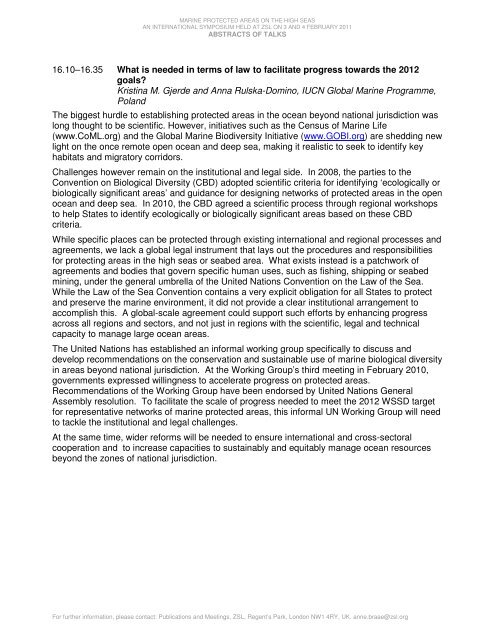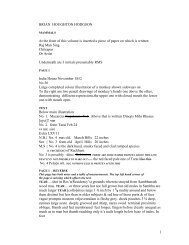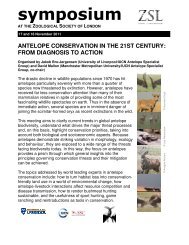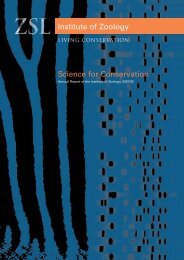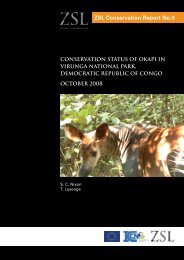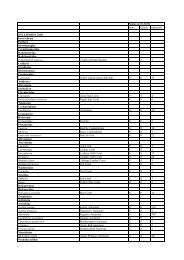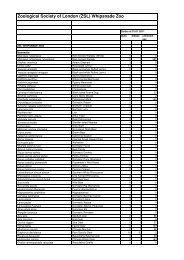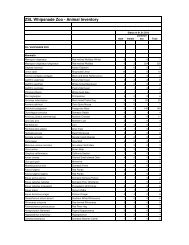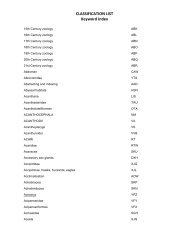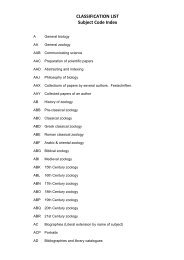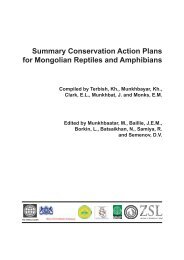MPA Symposium - Zoological Society of London
MPA Symposium - Zoological Society of London
MPA Symposium - Zoological Society of London
Create successful ePaper yourself
Turn your PDF publications into a flip-book with our unique Google optimized e-Paper software.
MARINE PROTECTED AREAS ON THE HIGH SEAS<br />
AN INTERNATIONAL SYMPOSIUM HELD AT ZSL ON 3 AND 4 FEBRUARY 2011<br />
ABSTRACTS OF TALKS<br />
16.10–16.35 What is needed in terms <strong>of</strong> law to facilitate progress towards the 2012<br />
goals?<br />
Kristina M. Gjerde and Anna Rulska-Domino, IUCN Global Marine Programme,<br />
Poland<br />
The biggest hurdle to establishing protected areas in the ocean beyond national jurisdiction was<br />
long thought to be scientific. However, initiatives such as the Census <strong>of</strong> Marine Life<br />
(www.CoML.org) and the Global Marine Biodiversity Initiative (www.GOBI.org) are shedding new<br />
light on the once remote open ocean and deep sea, making it realistic to seek to identify key<br />
habitats and migratory corridors.<br />
Challenges however remain on the institutional and legal side. In 2008, the parties to the<br />
Convention on Biological Diversity (CBD) adopted scientific criteria for identifying ‘ecologically or<br />
biologically significant areas’ and guidance for designing networks <strong>of</strong> protected areas in the open<br />
ocean and deep sea. In 2010, the CBD agreed a scientific process through regional workshops<br />
to help States to identify ecologically or biologically significant areas based on these CBD<br />
criteria.<br />
While specific places can be protected through existing international and regional processes and<br />
agreements, we lack a global legal instrument that lays out the procedures and responsibilities<br />
for protecting areas in the high seas or seabed area. What exists instead is a patchwork <strong>of</strong><br />
agreements and bodies that govern specific human uses, such as fishing, shipping or seabed<br />
mining, under the general umbrella <strong>of</strong> the United Nations Convention on the Law <strong>of</strong> the Sea.<br />
While the Law <strong>of</strong> the Sea Convention contains a very explicit obligation for all States to protect<br />
and preserve the marine environment, it did not provide a clear institutional arrangement to<br />
accomplish this. A global-scale agreement could support such efforts by enhancing progress<br />
across all regions and sectors, and not just in regions with the scientific, legal and technical<br />
capacity to manage large ocean areas.<br />
The United Nations has established an informal working group specifically to discuss and<br />
develop recommendations on the conservation and sustainable use <strong>of</strong> marine biological diversity<br />
in areas beyond national jurisdiction. At the Working Group’s third meeting in February 2010,<br />
governments expressed willingness to accelerate progress on protected areas.<br />
Recommendations <strong>of</strong> the Working Group have been endorsed by United Nations General<br />
Assembly resolution. To facilitate the scale <strong>of</strong> progress needed to meet the 2012 WSSD target<br />
for representative networks <strong>of</strong> marine protected areas, this informal UN Working Group will need<br />
to tackle the institutional and legal challenges.<br />
At the same time, wider reforms will be needed to ensure international and cross-sectoral<br />
cooperation and to increase capacities to sustainably and equitably manage ocean resources<br />
beyond the zones <strong>of</strong> national jurisdiction.<br />
For further information, please contact: Publications and Meetings, ZSL, Regent’s Park, <strong>London</strong> NW1 4RY, UK. anne.braae@zsl.org


